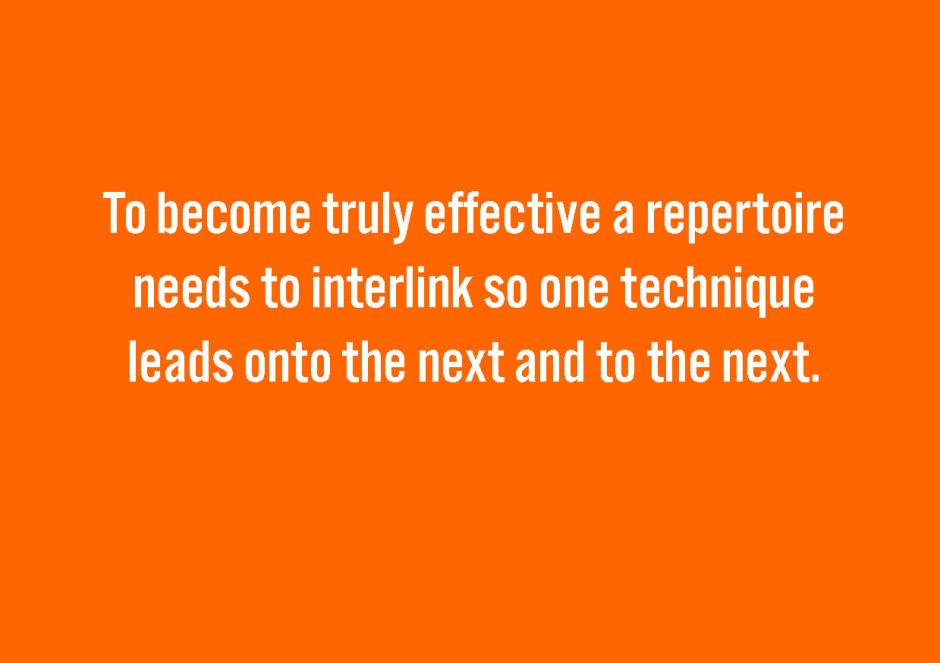Judo Book: Get this judo pdf guide on teaching movement and building a solid repertoire.

This judo book includes 10 Judo Drills to help you teach movement. Because building a decent wide judo repertoire with interlinking throws begins with getting bags of movement.
Someone who can throw an osoto-gari and an ouchi-gari is good.
Someone who can link those two throws is not twice as good but is many times better.
Teddy Riner’s (eight-time world champion) repertoire revolves around these six throws; ouchi-gari, osoto-gari, harai-goshi, uchi-mata, kouchi-gake, tani-otoshi – all of which he can use to devastating effect as a direct attack.
But his real skill is when he begins combining them.
When his ouchi-gari opens up a reaction for his osoto-gari, that in turn creates movement for his harai-goshi. His uchi-mata easily reverses into ouchi-gari that continues into a kosoto-gake.
But how do you get there?
How, do you teach a white belt to be able to link throws so one day they might be able to throw like Teddy?
A fight moves in patterns.
Some of them repeat, but they are infinite.
Different opponents of different sizes, speeds and skills add to the possibilities of directions and reactions.
Because of this it is much better to study a wide range of throws; your one tokui-waza will soon become useless as it becomes known.
Much better to have ten techniques you can score a yuko with than one you can score an ippon with.
So, a better question we might ask ourselves is how to choose the techniques we are going to teach?
And the answer lies in covering all the directions.
Directions provided the starting point for selecting the ten throws that you will find in our Top Ten Throws resource.
In a linear list they look like this: Kouchi-gari, Ouchi-gari, Ippon Seoi-Nage, Tai-Otoshi, Uchi-mata, Sumi-Gaeshi, Harai-Goshi, De-ashi-barai, Morote Seoi Nage and Osoto-Gari.
Put them in a circle, however…
… and you’ll see they cover all the main throwing directions.
Try this quick exercise.
Grab a piece of paper and a pencil.
Draw a set of circles like this.

What’s your judo repertoire?
For all throws you can score an ippon with (regularly in randori or shiai) draw a thick line from the centre to the edge of the final circle – in the direction of that throw.
For example a right-handed judoka throwing with Osoto-Gari would draw a line towards the back diagonal (as this is the direction of a well aligned Osoto-Gari.)
What does your circle look like?
To which direction are you strongest?
Any weak areas?
Now try the same exercise adding your coaching repertoire.
What throws do you regularly teach?
Ryoko Tani-Tamura is widely regarded as the best judoka in history winning seven world titles and five Olympic medals; she could throw for ippon with almost any waza and in all directions. Her repertoire when placed into a circle looks something like this:

But how do you teach that?
We will get onto that next.
But first, a quick and shameless plug (!) about two of our resource packs that you might find handy if you are looking to teach a repertoire. Top Ten Throws Bundle and Advanced Judo Bundle gives you visual materials to support the teaching of ten throws and twenty combinations.
You can jump straight to buying teaching resources here or first look at how to teach movement using Kakari Geiko.
It it is time to get your judoka moving.

Learning a technique progresses through three stages:
Learning the fundamentals of the technique – in a static situation.
Learning to adjust those fundamental when movement is applied.
Learning to link the technique with others in combinations.
Kakari Geiko introduces movement…
Kakari Geiko (often called Butsukari) is an excellent drill to teach movement. Kakari Geiko is similar to randori, but only tori attacks.
It’s enough at first for tori and uke to move around the mat, freely in various directions and uke to attack with the choosen technique.

Over time, the kakari-geiko drill can become more sophisticated.
Uke can provide problems for tori to solve; uke can tai-sabaki, evade throws, dodge, react, go left-handed, go right-handed, be fast, be slow…
Uke provides problems so tori might learn; uke is not trying beat tori.
And over time, the judoka learns by discovery.
Patterns begin to reemerge, instincts and intuitions develop as movement is encoded into the implicit memory.
Soon, the judoka can link from one throw to the next.

In Advanced Judo we move onto making sure our top ten throws link up.
Each of those ten throws has two combinations.
Even by my poor maths that makes twenty combinations in all.
Which opens up in time as skill into hundreds of options.
Your judoka will have a wide and balanced repertoire that interlinks enabling them to throw in any direction.
Next up … we look at ten drills to teach movement, but in the meantime please feel free to download our e-book. Yes, it’s free!
All we ask from you is your email (which we will of course treat with respect and only contact you occasionally to let you know about resources we are developing to use to teach judo). Of course, if you also feel like clicking those annoying buttons on the side and sharing this post you will hugely be helping us in our mission to promote junior judo!
Freebie!
Download our free «How To Teach Movement» e-book with ten drills to use at the dojo or find out how you can use visual resources to compliment and reinforce your coaching at your dojo.
Judo Book: download it here.

Get the 10 judo drills by downloading our free-judo book or jump over to this post where we delve straight into five judo drills to get your judoka moving!
Social Share!
If you have liked this blog, or the e-book we’d really appreciate if you click those buttons on the side of the page, share, tweet, whatsapp or email to point other judo friends in this direction! Thank you.
Win a T-shirt!
Click the banner to enter the prize draw.
If you would like to host this banner on your website and give your members the chance to win a T-shirt then please contact us and we will send you the images!










